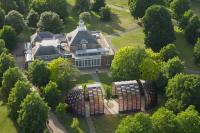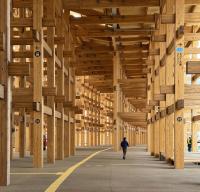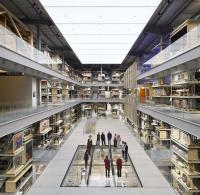Leoben Centre of Justice
Leoben, Austria
The location and topography of the site for the judicial centre lead logically to the arrangement of the court building facing the town, placed behind the judicial institution. An urban planning indication for the expansion of the city centre of Leoben is created by very clear building bodies whose scale corresponds with their use.
In its execution as a ‘belle façade’ facing the city, the court building comes across as an open and transparent building representing the new self-image of justice. No ‘judicial palace’, but a modern open ‘service facility’ for citizens. The court institutions, provincial court, public prosecution service and district court are connected by means of the three-storey entrance hall. The floors above house office and administration rooms for the corresponding courts, which are again highlighted by individual building bodies. The double façade in the administration wing made possible the timber surfacing of the interior skin.
The concept for the multiply-secured judicial institution follows a basic structure that was developed in advance. This structure runs behind the entrance, administration and visitor area along a distribution level with intersecting facilities and staggered detainment units; it is both horizontally and vertically expandable. This system was implemented in a very compact fashion in Leoben, although the most important organisational and design-related criterion was optimisation of the quality of experience for both employees and inmates as occupants. To this end, living conditions were created that are similar to everyday life at liberty in terms of home, work and leisure and which will, in the best case, make re-socialisation measures superfluous. The detainment units are designed like flat-sharing communities, each housing up to fifteen people. Each unit has a small kitchen, sanitary unit, gym and day room as well as a loggia that extends internal freedom of movement by the dimension of ‘stepping outside’. Work and leisure facilities are conceived in such a way that inmates can access them independently without being accompanied. This relieves staff of some burden and prevents total restriction. Courtyards assigned to one respective department, the promenade garden on the roof and sports facilities act as a filter between inmates and wall, but are designed to make sure that no prohibited contact between inside and outside can be made. However, in their dimension and size they put people first, completing the microcosm of a modern judicial institution.
Awards
ULI - Urban Land Institute for Excellence 2009: Europe, Middle East and Africa
Architecture prize of Styria Province 2004
Geramb-Rose, appreciation award for excellent construction 2006
- Architects
- hohensinn architektur
- Location
- Dr. Hanns-Groß-Strasse 7 + 9, 8700 Leoben, Austria
- Year
- 2004














